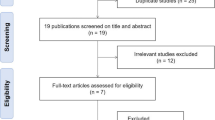Abstract
The treatment of stable non-segmental vitiligo is often challenging, which new therapies are being searched. Multiple clinical trials have proposed the benefits and safety of using fractional carbon dioxide (CO2) laser as an adjunct therapy to conventional treatments. This study aimed to evaluate the safety and efficacy of fractional carbon dioxide laser as a combination therapy to conventional treatments in patients with stable non-segmental vitiligo. A literature search using PubMed, EMBASE, and the Cochrane Library was performed for comparative studies among vitiligo patients treated with additional fractional CO2 laser. Clinical outcomes in the selected studies were compared, and a meta-analysis was performed via Review Manager version 5.3, according to the PRISMA guidelines. Six studies with a total of 184 patches/patients were included in the present meta-analysis. The combination therapy group had significantly superior results than that of the control group (≥ 75% re-pigmentation, risk ratio [RR] 2.80, 95% confidence interval [CI] 1.29–6.07; ≥ 50% re-pigmentation, RR 2.26, 95% CI 1.23–5.9; < 25% re-pigmentation, RR 0.57, 95% CI 0.43–0.75). Limitations of the study included the small number of studies and sample size, inadequate blinding of participants, and variation between therapy protocols. Meta-analysis revealed that using fractional CO2 laser in combination with conventional treatments is efficient and safe, and may be considered as an adjunct therapeutic option for patients with refractive non-segmental vitiligo.





Similar content being viewed by others
References
Alikhan A, Felsten LM, Daly M, Petronic-Rosic V (2011) Vitiligo: a comprehensive overview: part I. Introduction, epidemiology, quality of life, diagnosis, differential diagnosis, associations, histopathology, etiology, and work-up. J Am Acad Dermatol 65(3):473–491
Abdelghani R, Ahmed NA, Darwish HM (2017) Combined treatment with fractional carbon dioxide laser, autologous platelet-rich plasma, and narrow band ultraviolet B for vitiligo in different body sites: a prospective, randomized comparative trial. J Cosmet Dermatol
Speeckaert R, van Geel N (2017) Vitiligo: an update on pathophysiology and treatment options. Am J Clin Dermatol:1–12
Vachiramon V, Chaiyabutr C, Rattanaumpawan P, Kanokrungsee S (2016) Effects of a preceding fractional carbon dioxide laser on the outcome of combined local narrowband ultraviolet B and topical steroids in patients with vitiligo in difficult-to-treat areas. Lasers Surg Med 48(2):197–202
Jalali MA, Jafari B, Isfahani M, Nilforoushzadeh MA (2013) Treatment of segmental vitiligo with normal-hair follicle autograft. Med J Islam Repub Iran 27(4):210
Moher D, Liberati A, Tetzlaff J, Altman DG, Group P (2010) Preferred reporting items for systematic reviews and meta-analyses: the PRISMA statement. Int J Surg 8(5):336–341
Yan R, Yuan J, Chen H, Li Y-H, Wu Y, Gao X-H, Chen H-D (2017) Fractional Er:YAG laser assisting topical betamethasone solution in combination with NB-UVB for resistant non-segmental vitiligo. Lasers Med Sci 32(7):1571–1577
Khatri KA, Ross V, Grevelink JM, Magro CM, Anderson RR (1999) Comparison of erbium:YAG and carbon dioxide lasers in resurfacing of facial rhytides. Arch Dermatol 135(4):391–397
Ross EV, Yashar SS, Naseef GS, Barnette DJ, Skrobal M, Grevelink J, Anderson R (1999) A pilot study of in vivo immediate tissue contraction with CO2 skin laser resurfacing in a live farm pig. Dermatol Surg 25(11):851–856
Ortiz AE, Goldman MP, Fitzpatrick RE (2014) Ablative CO2 lasers for skin tightening: traditional versus fractional. Dermatol Surg 40:S147–S151
Hædersdal M, Sakamoto FH, Farinelli WA, Doukas AG, Tam J, Anderson R (2010) Fractional CO2 laser-assisted drug delivery. Lasers Surg Med 42(2):113–122
Kumar R, Parsad D, Kanwar A, Kaul D (2011) Altered levels of Ets-1 transcription factor and matrix metalloproteinases in melanocytes from patients with vitiligo. Br J Dermatol 165(2):285–291
Allemann IB, Kaufman J (2010) Fractional photothermolysis—an update. Lasers Med Sci 25(1):137–144
Bayoumi W, Fontas E, Sillard L, Le Duff F, Ortonne JP, Bahadoran P, Lacour JP, Passeron T (2012) Effect of a preceding laser dermabrasion on the outcome of combined therapy with narrowband ultraviolet B and potent topical steroids for treating nonsegmental vitiligo in resistant localizations. Br J Dermatol 166(1):208–211
Cunha PR, Scabine Pessotti N, Bonati Mattos C, Salai AF (2017) New approach in the treatment of refractory vitiligo: CO2 laser combined with betamethasone and salicylic acid solution. Dermatol Ther 30 (1)
Hélou J, Maatouk I, Obeid G, Moutran R, Stephan F, Tomb R (2014) Fractional laser for vitiligo treated by 10,600 nm ablative fractional carbon dioxide laser followed by Sun exposure. Lasers Surg Med 46(6):443–448
Kanokrungsee S, Chanprapaph K, Chaiyabutr C, Vachiramon V (2016) A comparative study of combined treatment with fractional carbon dioxide and targeted ultraviolet B phototherapy for facial vitiligo. Lasers Med Sci 31(7):1343–1349
Shin J, Lee J, Hann SK, Oh S (2012) Combination treatment by 10,600 nm ablative fractional carbon dioxide laser and narrowband ultraviolet B in refractory nonsegmental vitiligo: a prospective, randomized half-body comparative study. Br J Dermatol 166(3):658–661
Yuan J, Chen H, Yan R, Cui S, Li Y-H, Wu Y, Gao X-H, Chen H-D (2016) Fractional CO2 lasers contribute to the treatment of stable non-segmental vitiligo. Eur J Dermatol 26(6):592–598
Role of funding source
We had no funding source providing financial support for the conduct of the research.
Author information
Authors and Affiliations
Contributions
Study conception and design: Yu-Jen Chiu and Hsu Ma.
Acquisition of data: Yu-Jen Chiu and Cherng-Kang Perng.
Analysis and interpretation of data: Yu-Jen Chiu, Cherng-Kang Perng, and Hsu Ma.
Drafting of manuscript: Yu-Jen Chiu.
Critical revision: Hsu Ma.
Corresponding author
Ethics declarations
Conflict of interest
The authors declare that they have no conflict of interest.
Ethical approval
All procedures performed in studies involving human participants were in accordance with the ethical standards of the institutional and/or national research committee and with the 1964 Helsinki declaration and its later amendments or comparable ethical standards.
For this type of study, formal consent was not required.
Financial disclosure statement
None of the authors has a financial interest in any of the products, devices, or drugs mentioned in this manuscript.
Rights and permissions
About this article
Cite this article
Chiu, YJ., Perng, CK. & Ma, H. Fractional CO2 laser contributes to the treatment of non-segmental vitiligo as an adjunct therapy: a systemic review and meta-analysis. Lasers Med Sci 33, 1549–1556 (2018). https://doi.org/10.1007/s10103-018-2516-7
Received:
Accepted:
Published:
Issue Date:
DOI: https://doi.org/10.1007/s10103-018-2516-7




